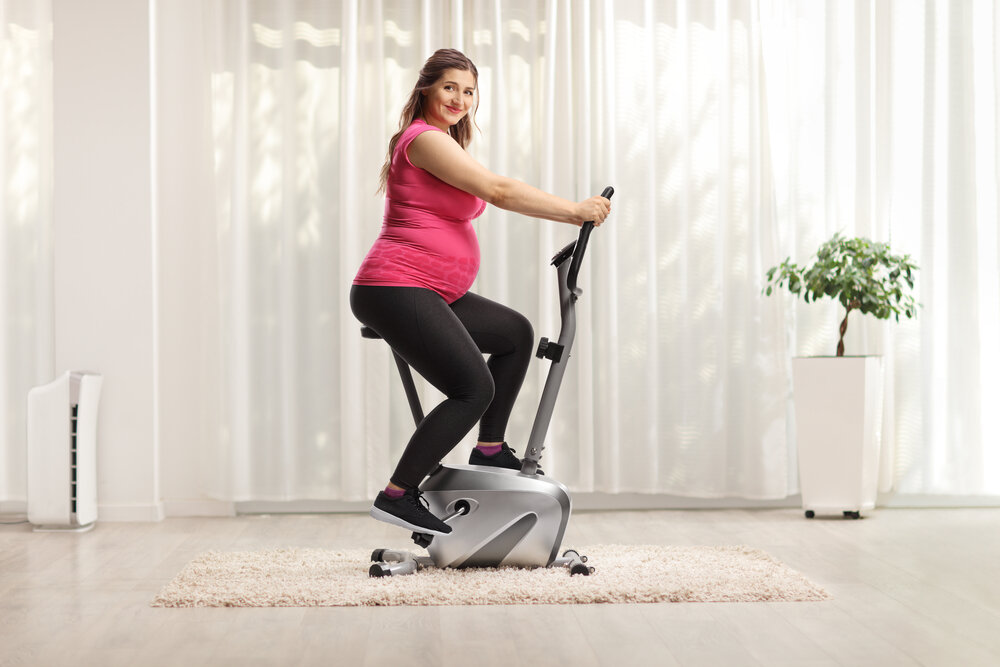Biking as a Low-Impact Exercise during Pregnancy
Pregnancy is a critical period for expecting mothers, and regular exercise is essential to maintain a healthy body and mind. Low-impact exercises, such as bicycle riding, are highly recommended during pregnancy due to their numerous benefits. Bicycle riding while pregnant can improve cardiovascular health, reduce back pain, and increase muscle strength, making it an excellent option for expecting mothers who want to stay active and healthy.
Understanding the Safety Measures for Bicycle Riding while Pregnant
Bicycle riding while pregnant can be a safe and enjoyable exercise option for expecting mothers, provided that they follow certain safety measures. The first and most crucial step is to wear a properly fitted helmet that meets the safety standards of the Consumer Product Safety Commission (CPSC). A well-fitted helmet can protect the head and neck from injuries in case of accidents. Additionally, expecting mothers should choose a comfortable and upright riding position to reduce the strain on the back and pelvic muscles. Maintaining good posture while bicycle riding can also improve breathing and circulation, which are essential for a healthy pregnancy.
Another critical safety measure for bicycle riding while pregnant is to choose safe and well-lit routes. Expecting mothers should avoid high-traffic areas and uneven terrains, such as gravel roads or mountain trails, which can increase the risk of accidents and injuries. Instead, they should opt for dedicated bicycle lanes, parks, or quiet residential streets with minimal traffic. Riding during daylight hours or in well-lit areas can also enhance visibility and reduce the risk of accidents.
How to Adapt Bicycle Riding as Pregnancy Progresses
As pregnancy advances, expecting mothers may need to make some adjustments to their bicycle and riding style to ensure their comfort and safety. One of the most important adjustments is lowering the seat to accommodate the growing belly and reducing the pressure on the pelvic area. Expecting mothers can also adjust the handlebars to a higher position to maintain an upright and comfortable riding position. Using a wider and more comfortable saddle can also provide additional support and cushioning to the sensitive areas.
Another option for expecting mothers is to use a stationary bike or a recumbent bike, which can provide a more comfortable and supportive riding position. Stationary bikes are an excellent choice for indoor exercise during inclement weather or when expecting mothers feel less confident about riding outside. Recumbent bikes, on the other hand, allow expecting mothers to recline and pedal with their feet in front of them, reducing the strain on the back and pelvic muscles. Recumbent bikes are also more stable and less likely to tip over, making them a safer option for expecting mothers.
Real-Life Examples of Bicycle Riding during Pregnancy
Many expecting mothers have successfully incorporated bicycle riding into their pregnancy exercise routine, and their experiences can inspire and motivate other expecting mothers. For instance, Sarah, a 28-year-old expecting mother, continued to ride her bicycle to work until her seventh month of pregnancy. She adjusted her seat height, handlebars, and saddle width to accommodate her growing belly and ensured her safety by wearing a properly fitted helmet, choosing safe and well-lit routes, and avoiding high-traffic areas. Sarah reported that bicycle riding helped her maintain her physical fitness, boost her mood, and reduce her stress levels during pregnancy.
Another example is Lisa, a 32-year-old expecting mother, who switched to a stationary bike during her third trimester. She found that the recumbent position of the stationary bike provided additional support and comfort to her back and pelvic muscles, reducing the strain and discomfort associated with pregnancy. Lisa combined her stationary bike workouts with prenatal yoga and walking, creating a well-rounded and balanced exercise routine that helped her stay healthy and active throughout her pregnancy.
Consulting with Healthcare Providers before Bicycle Riding during Pregnancy
Before starting any new exercise routine during pregnancy, it is crucial to consult with healthcare providers to ensure safety and avoid any potential risks. Expecting mothers should discuss their medical history, current health status, and pregnancy-related complications with their healthcare providers to determine whether bicycle riding is a suitable exercise option for them. In general, healthcare providers recommend low-impact exercises, such as bicycle riding, during pregnancy, as they can provide numerous benefits for both the expecting mother and the developing fetus.
However, some expecting mothers may have certain medical conditions or pregnancy-related complications that may contraindicate bicycle riding or require special considerations. For instance, expecting mothers with a history of preterm labor, placenta previa, or other high-risk pregnancy complications may need to avoid bicycle riding or modify their exercise routine to reduce the risk of complications. By consulting with healthcare providers, expecting mothers can make informed decisions about their exercise routine and ensure their safety and well-being during pregnancy.
Staying Hydrated and Nourished during Bicycle Riding while Pregnant
Staying hydrated and nourished is crucial during bicycle riding while pregnant. Expecting mothers should consume plenty of fluids before, during, and after exercise to prevent dehydration and maintain optimal hydration levels. It is recommended to drink at least 8 to 10 glasses of water or other hydrating beverages, such as coconut water or electrolyte-infused drinks, throughout the day. Expecting mothers should also avoid caffeine, alcohol, and sugary drinks, which can dehydrate the body and increase the risk of complications.
In addition to hydration, expecting mothers should also focus on nourishing their bodies with healthy and balanced meals and snacks. Expecting mothers should consume a variety of nutrient-dense foods, such as fruits, vegetables, whole grains, lean proteins, and healthy fats, to provide the necessary energy and nutrients for themselves and their developing fetus. Expecting mothers should also avoid processed and junk foods, which can contribute to weight gain, inflammation, and other pregnancy-related complications.
To recognize and manage the signs of dehydration and low blood sugar, expecting mothers should pay attention to their body’s signals and respond accordingly. Some common signs of dehydration include thirst, dry mouth, fatigue, dizziness, and dark-colored urine. To manage dehydration, expecting mothers should drink fluids regularly, even if they don’t feel thirsty, and seek medical attention if symptoms persist or worsen. Some common signs of low blood sugar include sweating, shaking, hunger, confusion, and rapid heartbeat. To manage low blood sugar, expecting mothers should consume healthy and balanced meals and snacks regularly, avoid skipping meals, and seek medical attention if symptoms persist or worsen.
Combining Bicycle Riding with Other Pregnancy Exercises
Combining bicycle riding with other pregnancy exercises can provide a well-rounded and balanced exercise routine for expecting mothers. Swimming, yoga, and walking are excellent exercises that can complement bicycle riding and provide additional benefits for expecting mothers. Swimming, for instance, can provide a low-impact and full-body workout that can improve cardiovascular health, reduce back pain, and increase muscle strength. Yoga can provide a mind-body exercise that can improve flexibility, balance, and mental well-being. Walking can provide a low-impact and accessible exercise that can improve cardiovascular health, reduce back pain, and increase muscle strength.
Combining these exercises can provide a variety of movements and challenges that can keep expecting mothers engaged and motivated. For instance, expecting mothers can start their exercise routine with a 30-minute bike ride, followed by a 30-minute swim or yoga session, and ending with a 30-minute walk. This routine can provide a balanced exercise routine that can improve overall fitness, reduce pregnancy-related discomforts, and promote a healthy pregnancy. Expecting mothers should consult with their healthcare providers before starting any new exercise routine and adjust their exercise routine based on their fitness level, pregnancy stage, and individual needs.
Overcoming the Challenges of Bicycle Riding during Pregnancy
Bicycle riding during pregnancy can be a rewarding and enjoyable experience, but expecting mothers may face some challenges and barriers that can affect their motivation and enthusiasm. Fatigue, discomfort, and fear are common challenges that expecting mothers may encounter when bicycle riding during pregnancy. However, with the right strategies and solutions, expecting mothers can overcome these challenges and maintain a positive and enjoyable exercise experience.
To manage fatigue, expecting mothers should ensure they get enough rest and sleep, eat a balanced and nutritious diet, and adjust their exercise routine based on their energy levels. Expecting mothers should listen to their bodies and avoid pushing themselves too hard or too fast. They can also break their exercise routine into shorter sessions, such as 15-minute rides, and gradually increase the duration and intensity as their fitness level improves.
To manage discomfort, expecting mothers should ensure their bicycle is properly fitted and adjusted to their body size and shape. They should lower the seat, adjust the handlebars, and use a wider and more comfortable saddle. Expecting mothers can also wear comfortable and breathable clothing, such as moisture-wicking fabrics, and avoid riding in extreme temperatures or weather conditions. They can also perform stretching and flexibility exercises before and after their bike ride to reduce muscle tension and stiffness.
To manage fear, expecting mothers should choose safe and well-lit routes, wear a properly fitted helmet, and avoid high-traffic areas and uneven terrains. They can also ride with a partner or group, such as a local cycling club or group, to increase their visibility and safety. Expecting mothers can also take a cycling safety course or workshop to improve their cycling skills and confidence.








